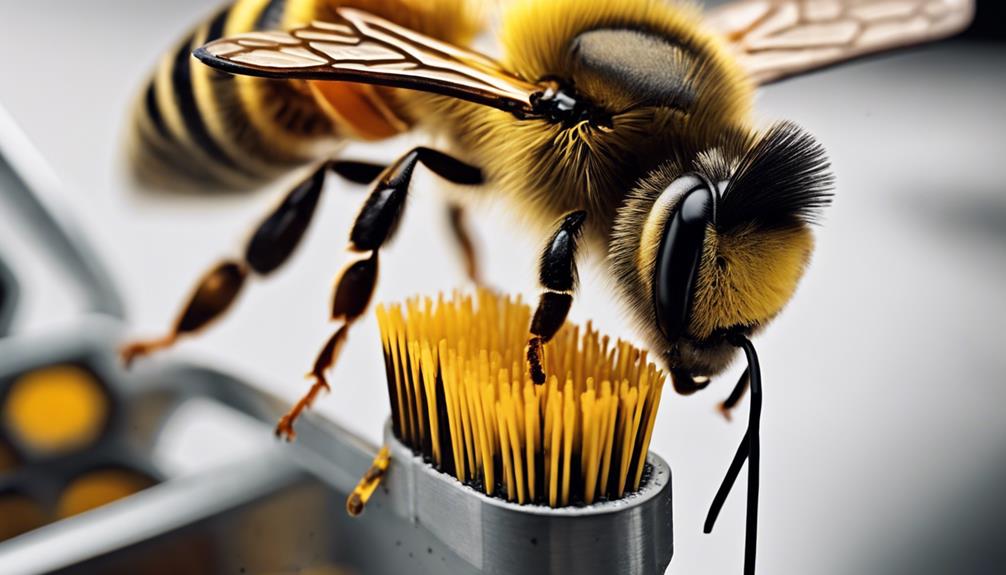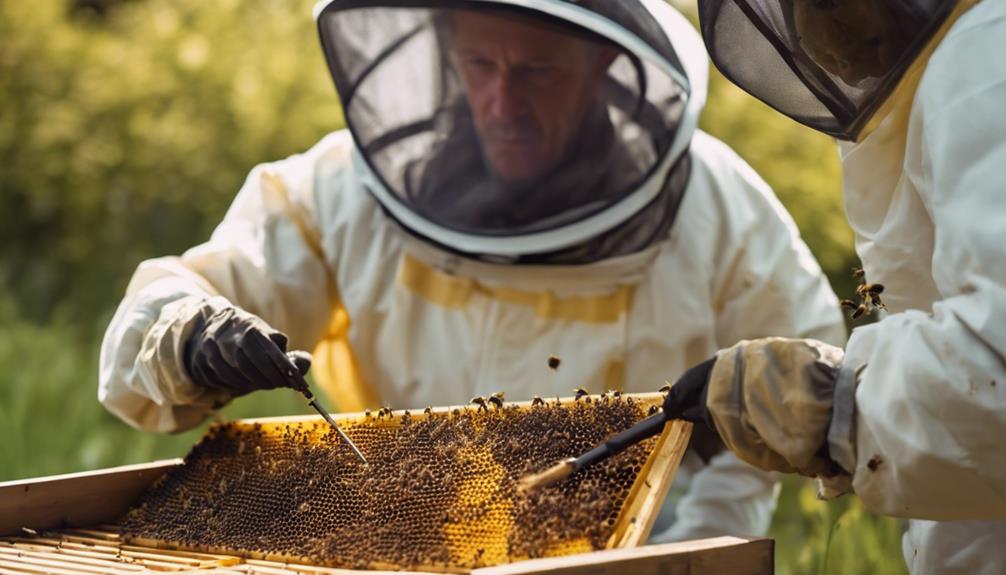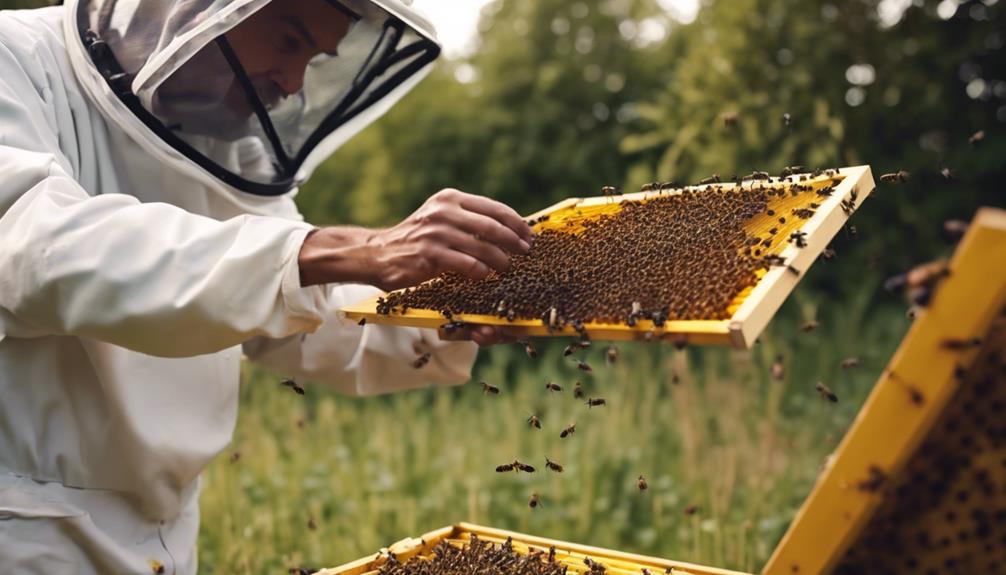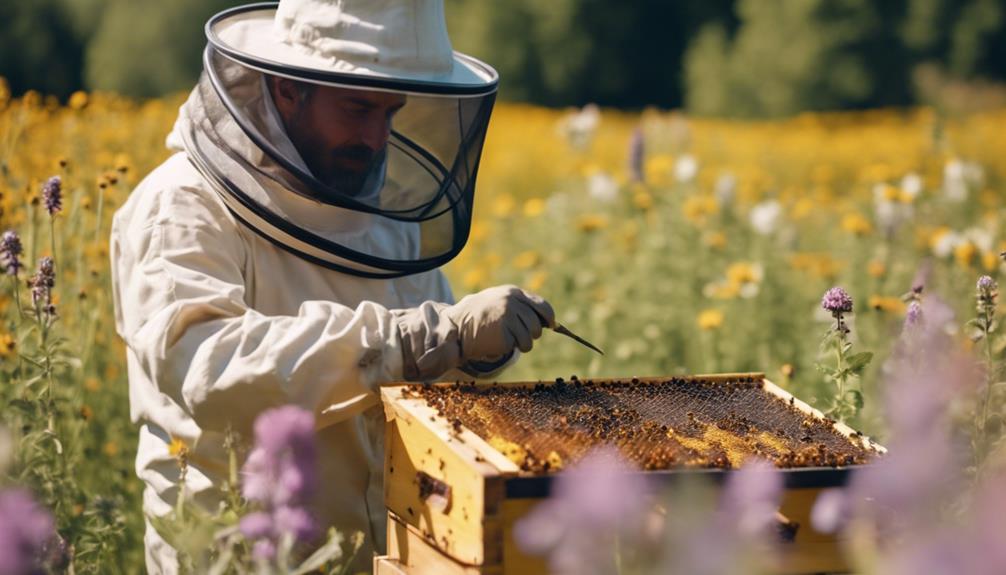So, have you ever wondered what a bee brush is used for? Well, let me tell you! Bee brushes are super handy in beekeeping – they help us handle our buzzing buddies gently and efficiently during hive inspections, queen rearing, and honey harvesting. These brushes are like the superheroes of the apiary world, ensuring the well-being of our precious pollinators while making our beekeeping tasks a breeze. If you’re curious to learn more about how these brushes can transform your beekeeping game, keep exploring!
Main Points
- Gentle removal of bees from frames.
- Ensures safety and efficiency in hive inspections.
- Helps with queen rearing and hive management.
- Delicate handling for clean end products.
- Historical significance in beekeeping practices.
Benefits of Using a Bee Brush
Using a bee brush provides multiple advantages for beekeepers, ensuring the safety and efficiency of hive inspections and various beekeeping tasks. Unlike stiff brushes that can harm bees, a bee brush is gentle, prioritizing the well-being of our buzzing friends during inspections.
This tool is a game-changer in beekeeping, making activities like raising queens and clearing bees off hive bodies more efficient. When we flick the bee brush with quick and assertive movements, we can move bees without causing them unnecessary agitation.
Remarkably, historical records even refer to bee brushes as Coggshall brushes, underlining their long-standing importance in beekeeping practices. For tasks like comb honey production, the bee brush delicately removes bees from frames, ensuring a clean and presentable end product.
How to Properly Handle a Bee Brush
When managing a bee brush, we must make sure to hold it perpendicular to the surface to avoid damage to brood or honey cells. By gently sweeping the brush bees away from the honeycomb, we can effectively clear them without causing harm.
It’s important to maintain a light touch, preventing any unnecessary pressure that could harm the delicate structure of the hive. Remember, bees are vital to our ecosystem, so handling them with care is paramount.
If you find that using the bee brush takes longer than expected, consider alternative methods like shaking frames or blowing bees off for quicker bee removal. By using the bee brush responsibly and avoiding excessive force, we can guarantee the safety of both the bees and their habitat.
Differences Between Bee Brushes and Other Tools

After mastering the proper handling of a bee brush, understanding the distinctions between bee brushes and other beekeeping tools is essential for efficient hive management.
Unlike tools such as fume boards or shaking frames, bee brushes offer a more precise and vital approach to bee removal. The soft bristles of a bee brush play a significant role in ensuring that delicate brood or honey cells remain unharmed during hive inspections.
Bee brushes are favored for tasks like queen rearing, making splits, and harvesting honey due to their ability to provide controlled and targeted bee removal. This level of precision allows beekeepers to efficiently clear bees from combs without causing unnecessary disturbance to the hive, making it a valuable tool in the beekeeper’s arsenal.
Tips for Selecting the Right Bee Brush
When selecting the appropriate bee brush, it’s important to take into account factors like bristle types, handle length options, as well as durability and quality.
These aspects play a significant role in the brush’s effectiveness and your overall beekeeping experience.
Brush Bristle Types
Selecting the right bee brush requires careful consideration of the bristle type, whether it be horsehair or plastic polymer, to guarantee effective and gentle bee handling. Horsehair bristles are a traditional choice, known for their softness that prevents harm to the bees. On the other hand, synthetic polymer bristles offer easy cleaning, which some beekeepers find convenient.
The bristle type plays a significant role in determining the firmness and efficiency of the bee brush. So, when picking out your bee brush, think about which bristle type aligns best with your beekeeping practices. Whether you lean towards the natural feel of horsehair or the practicality of synthetic polymer, the right bristle type will make sure that your bee handling tasks are smooth and stress-free.
Handle Length Options
When choosing a bee brush, consider the handle length options to guarantee top beekeeping efficiency and comfort. Longer handles provide extended reach, perfect for those deep hive boxes, while shorter ones offer better control in tight hive spaces. Here are some tips to help you choose the right handle length for your bee brush:
- Consider the depth of your hive boxes for best reach.
- Prioritize comfort to prevent fatigue during beekeeping tasks.
- Evaluate the level of maneuverability needed in your beekeeping routine.
- Balance reach and control to improve your efficiency when working with bees.
Selecting the ideal handle length ensures a smooth beekeeping experience, allowing you to manage tasks with ease and precision.
Durability and Quality
For optimal bee handling, it’s crucial to consider the bristle firmness of the bee brush before making a purchase. Choose a bee brush with soft bristles to guarantee you don’t harm the bees while effectively removing them from the hive.
Moreover, select a bee brush with a gentle design that’s specifically tailored for beekeeping tasks. This design won’t only be efficient in handling bees but also ensure their well-being during the process.
Prioritize investing in a bee brush that’s easy to clean to maintain bee health and preserve the quality of the brush for long-term use. By picking a bee brush with these characteristics, you can guarantee a smooth and secure beekeeping experience while prioritizing the bees’ welfare.
Common Mistakes to Avoid When Using a Bee Brush
One important aspect to keep in mind when using a bee brush is the gentle yet purposeful technique required to guarantee the safety and well-being of the bees. Here are some common mistakes to avoid when using a bee brush:
- Avoid being too aggressive: Remember, a gentle touch goes a long way in the hive environment.
- Mind the queen cells: Being cautious around these delicate areas helps protect developing queens.
- Steer clear of pheromones: Preventing the collection of alarm or sting pheromones keeps bees calm and content.
- Handle with care: Be mindful of your technique to make sure bees are gently moved without causing distress.
Enhancing Beekeeping Practices With a Bee Brush

To improve beekeeping practices effectively with a bee brush, it’s vital to master the proper handling techniques that prioritize the safety and well-being of the bees. The gentle removal of bees using a bee brush not only helps maintain bee health but also prevents unnecessary stress and potential harm to the delicate creatures.
By utilizing this tool correctly, beekeepers can guarantee the well-being of their colonies while efficiently managing tasks like queen rearing and harvesting. Additionally, the use of a bee brush plays a pivotal role in disease prevention by minimizing the spread of infections among bees.
Cleaning and Maintaining Your Bee Brush
Regularly cleaning your bee brush is vital to maintain its quality and promote bee health in the hive. To guarantee your bee brush stays in top condition, follow these simple maintenance tips:
- Clean bee brushes promptly after they come into contact with honey or propolis to prevent buildup, ensuring peak performance.
- Use warm water and a mild detergent like Dawn for effective cleaning without damaging the brush’s bristles.
- Regularly cleaning your bee brush is essential for maintaining its quality over time, allowing you to enjoy its benefits longer.
- Proper maintenance, including regular cleaning, not only preserves the brush but also promotes hygiene in the hive, benefiting the overall health of your bees.

Hello! My name is Noel Calvin. I graduated from UCLA and now work as a writer at Launch Ninjas. I write blog posts that inspire and guide our readers in their entrepreneurial pursuits. I live in Pleasantville, NJ, with a peaceful yet lively atmosphere that inspires me.
Writing stories is more than just a job for me. It allows me to share my observations and satisfy my curiosity about the world. I combine my analytical skills with creative enthusiasm to delve into technology trends and startup stories. But my life isn’t limited to screens and keyboards. I value loyalty, passion, and a touch of old-fashioned charm, which I infuse into every narrative I create.
I love spending time in my garage, jamming with my band when I’m not writing. Playing the guitar and singing bring me immense joy. I also enjoy capturing ordinary and extraordinary moments through my camera lens and exploring new culinary adventures that excite my taste buds. I’m always seeking new experiences.
My family is very important to me. Joyful Sunday brunches filled with laughter and intense board game nights keep me grounded, reminding me of life’s simple pleasures.
In my world, every moment is an opportunity for discovery. Every discovery is a story worth sharing, whether a heartfelt moment at home or the pulse of technological innovations. Join me as I navigate through life, one blog post, one guitar strum, and one heartwarming family dinner at a time.


